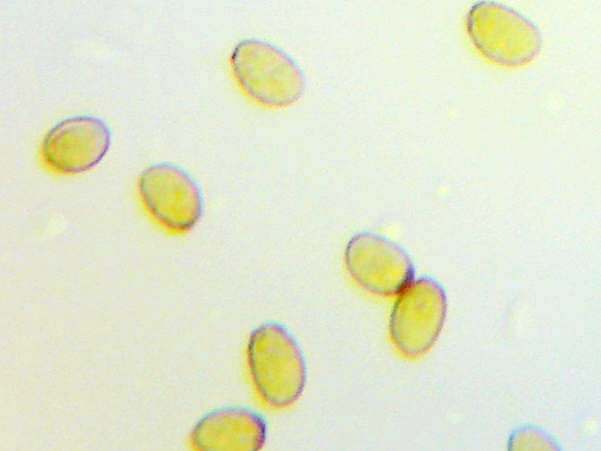Cortinarius semisanguineus (Fr.) Gillet - Surprise Webcap
Phylum: Basidiomycota - Class: Agaricomycetes - Order: Agaricales - Family: Cortinariaceae
Distribution - Taxonomic History - Etymology - Toxicity - Identification - Reference Sources
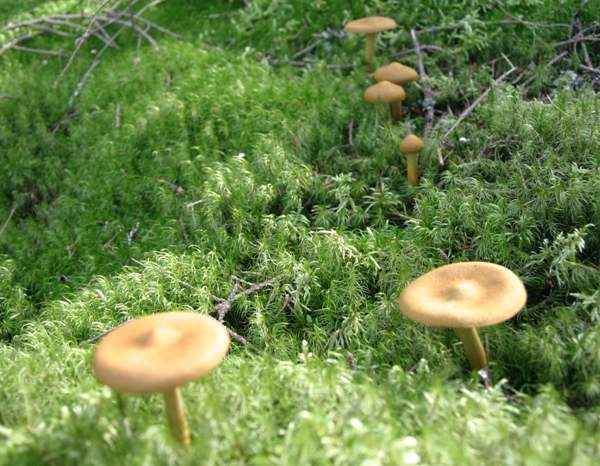
The pale colour of both cap and stem lead you to expect the gills to be pallid. Not so! The gills are blood red - hence the rather fanciful common name given recently to this species. (The specific epithet semisanguineus means half blood-red; a related species, Cortinarius sanguineus, has blood-red cap and gills and is known as the Bloodred Webcap).
The Surprise Webcap is found mainly in coniferous forests, but occasionally it also occurs in deciduous woodland under birches.
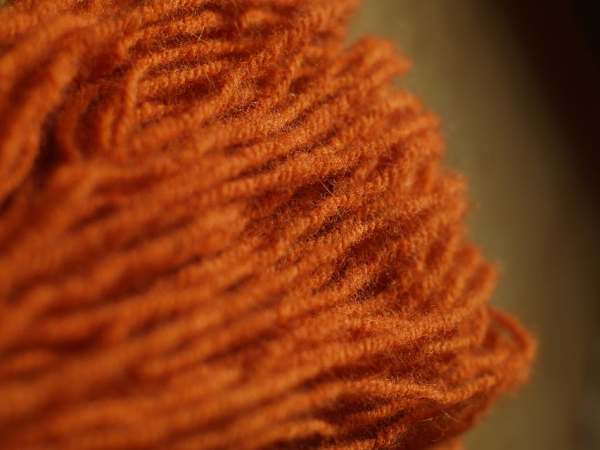
Here is another surprise: this webcap's gills can be used to produce a beautiful brown-orange dye. In Nordic countries this abundant mushroom was traditionally used to produce coloured wool like the sample of dyed yarn shown above. (Picture courtesy J Padatsu; Finland.)
Distribution
An occasional find in conifer forests throughout Britain, the Surprise Webcap is locally common particularly in spruce plantations where the trees are fairly mature. (Most mycorrhizal fungi will not fruit until their tree partners are well established, and some require ancient trees.) This webcap also occurs with birch trees in mixed woodland.
The Surprise Webcap occurs throughout most of northern and central mainland Europe and is a particularly common sight in the conifer forests of Scandinavia. Cortinarius semisanguineus occurs also in parts of North America.
Taxonomic history
This webcap was described in 1821 by the great Swedish mycologist Elias Magnus Fries, who gave it the name Agaricus cinnamomeus a semisanguineus and so established its basionym - the base name of its specific epithet. (In the early days of fungal taxonomy most gilled mushrooms were initially placed in a gigantic Agaricus genus; most of its contents have since been redistributed to other newer genera.) It was the French mycologist Claude-Casimir Gillet (1806 - 1896) who transferred this species to its current genus, thereby renaming it Cortinarius semisanguineus.
Synonyms of Cortinarius semisanguineus include Agaricus cinnamomeus a semisanguineus Fr., Cortinarius cinnamomeus ß semisanguineus (Fr.) Sacc., and Dermocybe semisanguinea (Fr.) M.M. Moser.
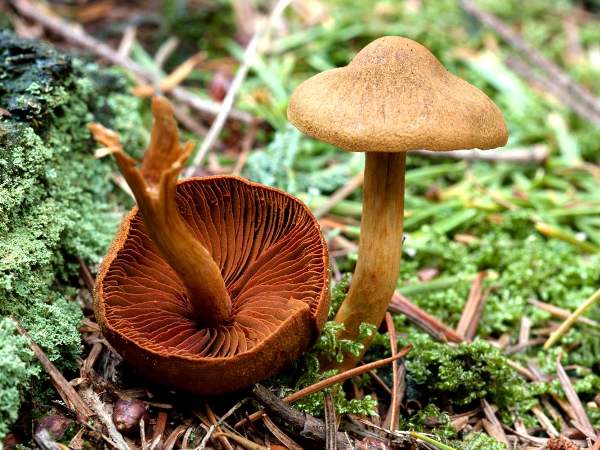
Etymology
The generic name Cortinarius is a reference to the partial veil or cortina (meaning a curtain) that covers the gills when caps are immature. In the genus Cortinarius most species produce partial veils in the form of a fine web of radial fibres connecting the stem to the rim of the cap rather than a solid membrane. The blood-red colour of the gills contrasting with the much paler colour of the cap is the basis of the specific epithet semisanguineus, which comes from Latin and simply means 'half blood red'.
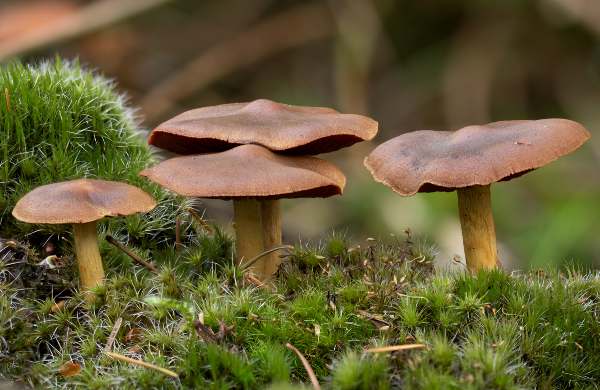
Toxicity
This mushroom is regarded as 'suspect' and may contain dangerous toxins; it should not be gathered for eating. Some reddish Cortinarius species with which the Bloodred Webcap could be confused contain the toxin orellanine, which if eaten destroys human kidneys and liver.
Identification guide
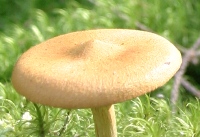 |
CapYellow or pale-to-mid olive-brown; convex, flattening with a distinct umbo; surface dry with fine fibrils or tiny scales; 3 to 6cm across. The cap surface turns instantly dark purple in reaction to a spot of KOH. The pale-capped example shown on the left was seen in a Swedish spruce forest. |
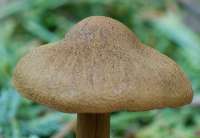 |
The more olive-brown-capped specimen shown here was photographed in the New Forest, southern England |
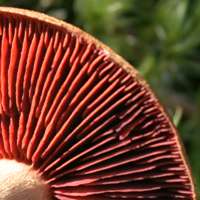 |
GillsThe adnate gills are close, and both the gill faces and the gill edges are initially blood red. |
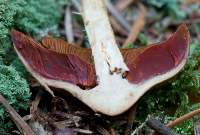 |
As the spores mature the gill faces turn brownish red while the gill edges become reddish brown. StemPale olive-yellow surface covered with light brown fibrils; cylindrical, often curved; 4 to 9cm long, 0.5 to 1.2cm diameter. The stem flesh is light ochre. |
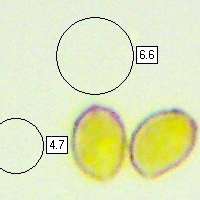 |
SporesEllipsoidal, with a rough surface, 6-8 x 4-5µm; inamyloid. Spore printRusty brown. |
Odour/taste |
Odour and taste slight, when cut or crushed, of radish. |
Habitat & Ecological role |
Ectomycorrhizal, in coniferous woodland; sometimes also under birches; singly or in scattered groups, very often in moss. |
Season |
August to October in Britain and Ireland. |
Similar species |
Cortinarius sanguineus, the Bloodred Webcap, has a blood-red cap as well as blood-red gills and stem. |
Reference Sources
Fascinated by Fungi, 2nd Edition, Pat O'Reilly 2016, reprinted by Coch-y-bonddu Books in 2022.
Funga Nordica, Henning Knudsen and Jan Vesterholt, 2008.
Fungi of Switzerland Agarics, part 3: Cortinariaceae, Breitenbach, J., Kränzlin, F.
British Mycological Society, English Names for Fungi
Dictionary of the Fungi; Paul M. Kirk, Paul F. Cannon, David W. Minter and J. A. Stalpers; CABI, 2008
Taxonomic history and synonym information on these pages is drawn from many sources but in particular from the British Mycological Society's GB Checklist of Fungi.
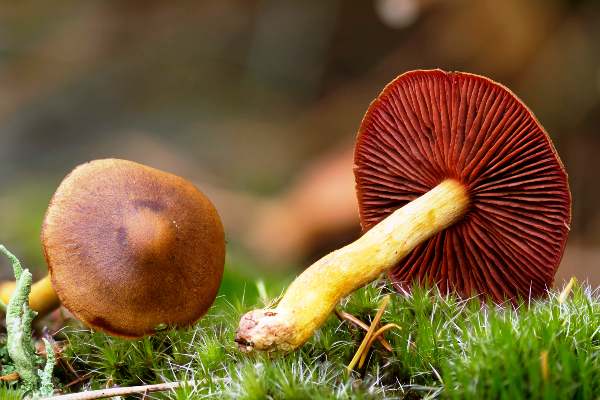
Acknowledgements
This page includes pictures kindly contributed by David Kelly.
Fascinated by Fungi. Back by popular demand, Pat O'Reilly's best-selling 450-page hardback book is available now. The latest second edition was republished with a sparkling new cover design in September 2022 by Coch-y-Bonddu Books. Full details and copies are available from the publisher's online bookshop...
